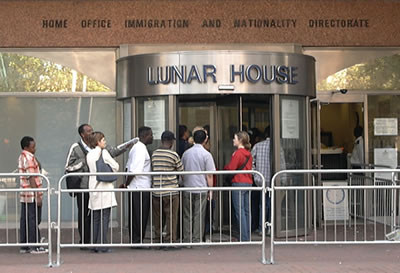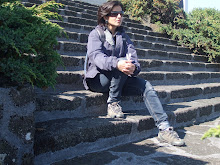The Roman Baths are below street level. The rising steam from the hot water spring gives it tremendous mystique. The Romans built a very sophisticated bathing and spa complex around it. During Roman times men and women would bathe naked in this pool. I can't imagine they didn't get up to some mischief.
The fan-vault ceiling of the Bath Abbey which stands right next to the Roman Baths. It has a gift shop which sells the most wicked fridge magnets. I bought one which says, "Fridge Pickers Wear Bigger Knickers."
The Royal Crescent - a grand sweep of semi-circular symmetry built many centuries after the Roman Baths. This was the fashionable end of town during Jane Austen's time. The best time to see the Crescent is in the morning when the sun is directly across it in the sky. It lights up this honey-coloured show-piece of Georgian architecture.
I had a wonderful time at the Fashion Museum in Bath. They have some really interesting sections like the one on the evolution of women's underwear and this one on English dress. What I still don't understand however, and I'm serious here, is how you can sit with a stiff frill on your bum?
When you go to Sally Lunn's restaurant in Bath to eat the world's best bun, remember to nip down to the basement for a quick peek into their kitchen museum.
Of all the empty seats in all the world, the woman with the whooping cough had to occupy the one opposite ours. We were on an early morning train to Bath in England, eager to get near its famed hot spring. Having just rid myself of flu germs, the last thing I wanted was to be bathed in hers.
If we were Romans visiting 2000 years ago we would have inscribed a curse on a strip of pewter and tossed it into the hot water, praying to the Goddess of healing, Sulis-Minerva, to pre-empt disease.
The only thing we could do really was jump off the train in relief when it pulled into the Bath Spa station. We crossed the new shopping mall and within less than four minutes we were standing in the heart of Bath, outside the entrance to the Roman temple and spa complex.
While the city centre still throbs because of what the Romans built nearly 2000 years ago, all around it are the layers of the centuries. We sought out the 20th c. by diving into a Costa for a bit of coffee and cake.
We took an hour to warm the insides waiting for the doors to open at 9.30. Straightaway, I grabbed the free audio guide for its interesting section with Bill Bryson’s observations and was eventually disappointed that he didn’t make any wise-cracks.
Unlike many Roman towns that came up around a fort, Bath developed because of its religious and ritualistic significance thanks to the hot spring. Today we understand the science behind the hot water but you really have to envy the powerful grip it must’ve had on Roman imagination - a dark green pool of steaming H2O curing all kinds of aches and pains. That’s why they erected a large temple and sprawling spa complex around the hot spring which continues to bring up nearly a million litres every single day at a toasty 46 degrees celsius.
The audio guide gives you so much freedom to explore at your own pace that we didn’t feel like joining the tour guide. In any case, he was so brusque with me that I lent him a cold shoulder instead of my ear.
The most entertaining section of the complex is the little museum which houses the Roman objects that were found in the spring. The Romans wished for all sorts of favours and blessings but the more colourful amongst them, threw in a fair number of curses as well, inscribed in Latin, which were later found at the bottom of the pool for the entertainment of future generations.
One guy complained, “Dacimedes has lost two gloves. He asks that the person who has stolen them should lose his minds and his eyes in the temple where she appoints.” Tough crowd!
From the Roman baths we hopped across to the Bath Abbey, which is much younger at about 500 years. We did a quick walk through gawking up at the pillars that merge with the ceiling by bursting into what look like Chinese palm fans. Its really quite beautiful but having woken up at 5.30 am that morning visions of a soft bed kept distracting us.
We decided to pack in one more thing before we retired and sought out the Pulteney Bridge. This is only one in four bridges in the world with shops on either side of it. It makes a pretty picture but being on the bridge itself felt like being on any other road in Bath. Underwhelmed, we decided it was time to check in to our B&B.
On Sunday morning we left the Roman bit of Bath behind to discover its Georgian end. This is the bit with the grand, honey-coloured buildings and where Jane Austen’s characters flitted and flirted. At that end of Bath you can quickly forget the Roman spa and I began to realize how much Bath is like Madonna. It has constantly reinvented itself.
After the Romans left, the Middle Ages, like the Middle Ages will, saw the spa complex go to ruin, till it was revived again in the 18th century and became the place to see and be seen for fashionable England. Jane Austen lived there briefly and rather unhappily and you can pick up fragments of her life around town as well as at the Jane Austen Centre. The owner of our B&B, warned us that it was the “Disney version for the American tourists” but I learnt a thing or two nonetheless.
We just walked and walked on Sunday checking out the beautiful Royal Crescent – a massive semi-circular building and the neighbouring Circus – a great big circular residential block. Bath’s Georgian architecture imitated the Italian Palladian style with its strict use of symmetry – all perfectly elegant as well.
We kept our last stop for the evening for the oldest house in Bath home to the Sally Lunn restaurant. Sally Lunn was allegedly a refugee from France who came to England nearly 300 years ago. She is credited with creating one of the most delicious buns I have ever tasted. Ever. When you tear off a piece, its like tearing off bits of cotton candy. Utterly and completely satisfied, we boarded the 8.30 train back to London with a bag full of buns, making it the oddest bit of shopping I have ever done.
Collapsing in my seat, I pulled out my list of ‘Things to do in Bath’ and found that 48 hours later, I could check off almost everything.
Trip Planner:
There are plenty of trains to Bath Spa station from London Paddington station. The train ride is an hour and a half. Tickets can be booked at http://www.thetrainline.com/. You can even do a day trip just to see the Roman baths. It is well worth staying in the UK for an extra day for it.
Where to Stay:
Bath is a really small town and you can get to all its attractions on foot. If you’re really exhausted taxis are cheap. This means that you don’t really have to stay in the middle of town near the Roman baths. Hotel prices can be quite expensive. We stayed at the Grove Lodge – a B&B off the London road which is a 20 minute level walk from the Roman baths. It is an excellent Georgian villa with tastefully decorated, spacious rooms and large bathrooms. The owner, a former teacher Isabel Miles offers a great vegetarian breakfast and good local advice on sight-seeing. 85 GBP a night. www.grovelodgebath.co.uk
When to go:
The best time is when it becomes warmer. But going in the winter ensures that you are not navigating throngs of tourists.
This piece was published in The Indian Express on 21st February 2010.





























